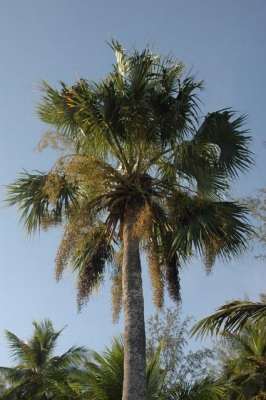Sabal domingensis
Becc.
Arecaceae
Sabal domingensis and Sabal causiarum are very similar spacies. Taxonomically, Sabal domingensis is distinguished from Sabal causiarum by its larger fruit. Unfortunately, fertile specimens of the two species are relatively few, causing confusion between the two species. Current evidence supports the fact that Sabal domingensis is primarily found in northern Hispaniola and Sabal causiarum is primarily found in southern Hispaniola, and that the two species overlap in their distribution where Sabal domingensis extends south in the Azua - Bani region along the Cordillera Central[
338- Title
- IUCN Red List of Threatened Species
- Publication
-
- Author
-
- Website
- http://www.iucnredlist.org/
- Publisher
-
- Year
- 0
- ISBN
-
- Description
- A list of plants under threat and facing possible extinction, usually with brief details of the threats and information on habitat.
].
Common Name: Latanier Chapeau

Plant growing in the Dominican Republic
Photograph by: John Dransfield
Image credit to Palmweb

Plant growing in the Dominican Republic
Photograph by: John Dransfield
Image credit to Palmweb

General Information
Sabal domingensis is a single-semmed, evergreen palm growing up to 10 metres tall. The stout, unbranched stem can be up to 60cm in diameter; it is topped by a crown of 20 - 30 leaves[
768- Title
- Field Guide to the Palms of the Americas
- Publication
-
- Author
- Henderson A.; Galeano G.; Bernal R.
- Publisher
- Princeton University Press; Princeton, New Jersey.
- Year
- 1995
- ISBN
- 0-691-08537-4
- Description
- An excellent book, giving basic information on all the 550 species of palms native to the Americas that were known in 1995. Comprehensive information on the plants range and habitat, brief description, some uses and almost 250 photos.
].
The plant is commonly harvested from the wild for its leaves, which are extensively used locally for thatching and weaving.
Sabal domingensis has a widespread and abundant population, it is tolerant to disturbed conditions and is widely cultivated in person-modified habitats, it is present in many protected areas including national parks, botanical gardens, scientific reserves and forest reserves, and has a stable population. The plant is classified as 'Least Concern' in the IUCN Red List of Threatened Species(2023)[
338- Title
- IUCN Red List of Threatened Species
- Publication
-
- Author
-
- Website
- http://www.iucnredlist.org/
- Publisher
-
- Year
- 0
- ISBN
-
- Description
- A list of plants under threat and facing possible extinction, usually with brief details of the threats and information on habitat.
].
Known Hazards
None known
Botanical References
768- Title
- Field Guide to the Palms of the Americas
- Publication
-
- Author
- Henderson A.; Galeano G.; Bernal R.
- Publisher
- Princeton University Press; Princeton, New Jersey.
- Year
- 1995
- ISBN
- 0-691-08537-4
- Description
- An excellent book, giving basic information on all the 550 species of palms native to the Americas that were known in 1995. Comprehensive information on the plants range and habitat, brief description, some uses and almost 250 photos.
Range
Caribbean - Dominican Republic, Hauti, Cuba.
Habitat
Secondary vegetation, at elevations from 100 - 1,000 metres[
768- Title
- Field Guide to the Palms of the Americas
- Publication
-
- Author
- Henderson A.; Galeano G.; Bernal R.
- Publisher
- Princeton University Press; Princeton, New Jersey.
- Year
- 1995
- ISBN
- 0-691-08537-4
- Description
- An excellent book, giving basic information on all the 550 species of palms native to the Americas that were known in 1995. Comprehensive information on the plants range and habitat, brief description, some uses and almost 250 photos.
].
Properties
| Conservation Status | Least Concern |
| Other Uses Rating |      |
| Habit | Evergreen Tree |
| Height | 7.00 m |
| Cultivation Status | Wild |
Cultivation Details
Not known
Edible Uses
None known
Medicinal
None known
Other Uses
The leaves are used for thatching[
768- Title
- Field Guide to the Palms of the Americas
- Publication
-
- Author
- Henderson A.; Galeano G.; Bernal R.
- Publisher
- Princeton University Press; Princeton, New Jersey.
- Year
- 1995
- ISBN
- 0-691-08537-4
- Description
- An excellent book, giving basic information on all the 550 species of palms native to the Americas that were known in 1995. Comprehensive information on the plants range and habitat, brief description, some uses and almost 250 photos.
].
The leaves are used for weaving hats, baskets, mats and other itmes[
768- Title
- Field Guide to the Palms of the Americas
- Publication
-
- Author
- Henderson A.; Galeano G.; Bernal R.
- Publisher
- Princeton University Press; Princeton, New Jersey.
- Year
- 1995
- ISBN
- 0-691-08537-4
- Description
- An excellent book, giving basic information on all the 550 species of palms native to the Americas that were known in 1995. Comprehensive information on the plants range and habitat, brief description, some uses and almost 250 photos.
].
Propagation
Seed -
If you have any useful information about this plant, please leave a comment. Comments have to be approved before they are shown here.
 Useful Tropical Plants Database 2014 by
Ken Fern,
web interface by
Ajna Fern
with help from
Richard Morris.
Useful Tropical Plants Database 2014 by
Ken Fern,
web interface by
Ajna Fern
with help from
Richard Morris.